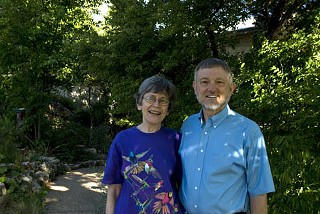Retired Teachers Preach the Gospel of Green
Won't you be my green neighbor?
By James Scott Bankston, Fri., April 18, 2008
Dale and Pat Bulla don't like doing yard work. The retired teachers are energetic and enthusiastic, but you won't see them mowing, raking, edging, watering, and fertilizing their lawn at their home in Northwest Austin. Yet in 2003, the city recognized them with a Green Garden award, and in February, the Jester Homeowners Association, in which the Bullas are active members, became the city's second Green Neighborhood winner.
Before the Bullas built their home in the late Nineties, they boned up on environmentally sound building practices and attended seminars at the Lady Bird Johnson Wildflower Center. It helped that they were already passionate nature lovers – they're both certified habitat stewards for the National Wildlife Federation and are active in a number of other nature groups.
Dale explained that during construction they implemented a "building envelope" – a green-building method of preserving as many native plants as possible. "We only removed the vegetation in the footprint of the house," he said. "We had staging areas for the plumbing, utilities, and driveway. And we fenced off all the rest of the vegetation."
The upkeep of the yard is pretty simple. "We plant stuff that belongs here – predominantly native plants," Pat says. "We do very little vegetable gardening, because you can't dig very deeply when you're sitting on limestone. ... We keep the place tidy, but we've found that if you save on your energy use, you wind up having to do less work."
Doing less work actually paid off in the long run with the Green Garden award. To win such a recognition, a homeowner must be a city of Austin water customer and meet at least seven criteria, including conservative yard watering, mulching, watering with rainwater, making pathways from water-permeable materials, using fertilizers sparingly – and then only in natural or organic brands – and using trees to shade the house and gardens, to name a few. Currently, 51 Austin homeowners have received this honor.
But any home ecologist worth his Birkenstocks will tell you that it's not enough for just one person to change his manner of living, gardening, and landscaping – the whole community should do so as well, hence the city's Green Neighborhood award. The relatively young program is built around the simple and seemingly obvious idea that the actions of each individual affect the water quality – and therefore the quality of life – of the entire community. An Austin neighborhood can be declared green if it racks up 50 or more credits by participating in activities like erecting a neighborhood "Scoop the Poop" box, sponsoring an official creek cleanup, or setting up a rainwater-collection demonstration site. The Copperfield neighborhood, situated along Walnut Creek in Northeast Austin, won the city's first such award in 2007.
The Jester group met several of the Green Neighborhood criteria. As part of its education program, the homeowners association has explained to residents that since Jester sits on top of the environmentally sensitive recharge zone of the Edwards Aquifer, any fertilizer or pesticide put on a lawn winds up tainting the cold, pristine aquifer. The association has marked storm drains with decorative tiles that warn of this danger.
Jester residents are also encouraged to apply for wildlife habitat certification from the National Wildlife Federation. Applicants list what sort of plant and animal life is on their property and explain how they engage in sustainable gardening practices and provide water, food, adequate cover, and proper places for animals to mate and raise their young. Thus far, more than 40 Jester households have received this certification.
While all of this might sound like a lot of trouble, the Bullas insist that it's only when we treat the landscape and the natural world in an artificial way that yard maintenance becomes an annoying, unfulfilling, expensive chore. In other words, you don't have to be rich, a fanatic, or an expert to pull off a green garden, but you do have to be open-minded. "The more people know," says Dale, "the better choices they make."
For more on the Green Garden and Green Neighborhood programs, visit the city's website at www.ci.austin.tx.us and click on "Environment" in the left-hand column.
Got something to say on the subject? Send a letter to the editor.







